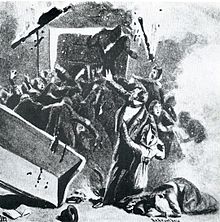Fire in the church of Grue
At least 113 people were killed on Pentecost Sunday , May 26th, 1822 in the fire of the church of Grue in the former Norwegian province of Hedmark (up in Innlandet in 2020 ) . The cause of Norway’s largest fire disaster to date has never been clarified beyond doubt.
The old church of Grue
The old church of the parish of Grue was located near Skulstad, about 130 kilometers northeast of Oslo not far from the Swedish border. The oldest parts of the wooden structure, which had been erected as a stave church , came from the 13th century. Around 1600 the church was expanded with side wings in block construction and a high central tower. There were galleries above the nave and side aisles of the church .
All three ships had entrance doors that opened inward. When open, the doors blocked access to the galleries. The leaded glass windows were fitted with iron bars on the outside. The red-painted church had been treated for centuries with wood tar , a highly flammable liquid that was supposed to protect the wood from the weather.
bad luck
The fire accident occurred on the warm, sunny Pentecost Sunday of 1822. With around 600 people attending the service, the church in Grue was filled to capacity. Pastor Iver Hesselberg , a follower of Grundtvig's teachings , had just started his sermon around 11 a.m. when a fire broke out on the outer wall of the south aisle. The fire quickly spread to the whole church, aided by the tar of wood, among other things. The inwardly opened doors made it impossible for people in the galleries to leave the church; a mass panic ensued . Many jumped down from the galleries because the stairs were blocked. They buried other people under them. After just 15 minutes, the tower of the church collapsed. After about an hour the whole church building collapsed.
Due to its construction, the church turned out to be a fire trap. At least 113 people died in the flames, some depictions say 116 or 117 fatalities. There were only eight adult men among the victims. The deaths of 69 women and 36 children under the age of 15 have been officially confirmed. This uneven distribution was due to the fact that men and women used different church entrances. Many men were able to get outside via the south exit, but the west entrance for women was blocked. Maids , other servants, and unmarried women were seated in the galleries .
Some people, including Pastor Hesselberg, were able to leave the church through individual windows whose glass they had partially broken. The melting lead rods caused severe burns. Other survivors suffered burns second and third degree. The bodies of the dead were so badly charred that only a single corpse could be identified after the fire disaster. This exception was the Vogt Dines Guldberg Høegh, who in the panic had tried in vain to calm the people down. His body could only be determined based on his saber and pocket watch. The victims of the fire accident were buried in five coffins on June 1, 1822. Only Guldberg Høegh received a single coffin.
The cause of the fire could not be determined. One theory suggests that the fire was started by a spark from a brazier that a sexton used to transport embers from a neighboring courtyard to light the altar candles. According to another version, a person outside the church is said to have experimented with a magnifying glass .
After the fire
In 1828 the new church of Grue parish was consecrated in another location, the center of Kirkenær . Before Stone recalls since 1922, a stone monument to the fire disaster. The saber of Vogts Guldberg Høegh is kept in the sacristy of the church.
The fire in the old church of Grue resulted in a law requiring doors in public buildings in Norway to open to the outside.
The lawyer and folklorist Kristian Østberg published a book about the Grue fire in 1897, which contains, among other things, eyewitness accounts. The philosopher Peter Wessel Zapffe deals with the fire in his novel Lyksalig pinsefest (Blessed Whitsun Festival) , published in 1972, and uses the misfortune to discuss the theodicy problem.
literature
- Kristian Østberg: Kirkebranden i Grue 1st pinsedag 1822 , Christiania 1897.
- Andreas Stub Guthe: Grue kirkes brann pinsedag 1822. Et 150 års minne , Grue 1972.
Web links
- Nina Aldin Thune: Grue . In: Store norske leksikon (accessed on May 23, 2017).
- Kirkene i Grue , Grue commune (accessed May 23, 2017).
- Anita Krok / Thor Holt: Inferno i Guds hus , Glåmdalen , June 1, 2012 (accessed May 23, 2017).
Individual evidence
- ↑ a b Lene Granli: Brant ned på én time , NRK Hordaland, 23 June 2009 (accessed on 23 May 2017).
- ↑ a b c d e Andreas Stub Guthe, Grue kirkes brann pinsedag 1822. Et 150 års minne , Grue 1972.
- ^ Nina Aldin Thune: Grue . In: Store norske leksikon .
- ↑ a b Anita Krok / Thor Holt: Inferno i Guds hus , Glåmdalen , June 1, 2012 (accessed on May 23, 2017).
- ↑ Kirkene i Grue ( Memento of the original from March 4, 2016 in the Internet Archive ) Info: The archive link was inserted automatically and has not yet been checked. Please check the original and archive link according to the instructions and then remove this notice. , Grue commune (accessed May 23, 2017).

